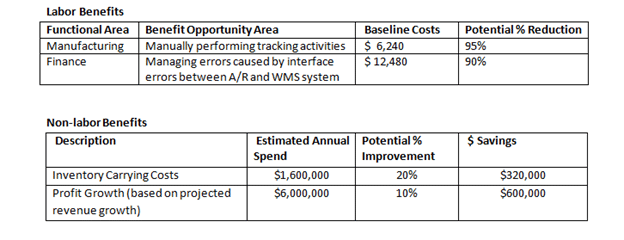When your CIO is the only executive involved in the ERP project; when managers believe the project won’t significantly impact their departments; when the goal of the project is IT-related – these are all examples of a lack of business-IT alignment.
It’s important to achieve business-IT alignment before an ERP project because it ensures your new ERP system supports your organizational goals.
However, many companies’ IT goals do not align with their business goals. For example, some companies implement new software simply because their legacy system is outdated, no longer supported or won’t allow them to scale for growth.
While these are good reasons to seek a new ERP system, they shouldn’t be the only reasons. Rather than just using the new system to replace your old system, you should use the new system to significantly improve your business.
When all stakeholders embrace this concept, you have the business-IT alignment necessary to begin a successful ERP selection.
Contents
1. Where You Need Alignment
2. Technology-focused vs. Business-focused ERP Projects
3. ERP Implementations vs. Digital Business Transformations
4. How to Achieve Business-IT Alignment (corporate strategy, executive steering committees, and more)
5. Why Executives Say No
6. How to Ensure Executive Buy-in
7. How to Show the Value of Change Management
8. How to Answer Executives’ Top Questions
9. Conclusion
Where You Need Alignment
In the context of an ERP project, we look at business-IT alignment in two ways: 1) the alignment of project goals with business goals; and 2) the alignment of stakeholders around project goals.
More specifically, there are seven areas where you need alignment:
1. The Nature of the Project
An ERP implementation is not an IT initiative. In fact, the human side of an ERP project has a significant impact on ERP success.
To ensure employees understand this concept, your CIO should shift focus from IT strategy to business strategy. This is no small feat. Navigating the dizzying array of technology options is time-consuming, leaving little time to consider business objectives.
In addition to understanding business objectives, it’s important to understand the magnitude of proposed changes. This enables you to understand the impact of change so you can plan for the appropriate organizational change management activities.
When executives and employees are clear about the project goals and the degree of change, they will know how to support the ERP project team in their search for the right system.
2025 Top 10 Manufacturing ERP Systems Report
Are you a mid- to large-sized manufacturing firm? This report is for you. Download it now to learn what kind of advanced functionality is available in the market today.
2. The Role of the IT Department
CIOs and their IT departments are often disconnected from executive teams and business needs. To mitigate this disconnect, IT staff should be encouraged to learn more about the functional side of ERP, CRM or whatever enterprise technology the organization is evaluating.
It’s bad news when technically-focused IT departments are tasked with everything from software selection to change management communication. While they might get the system up and running, and staff might use it to perform basic functions, it will probably never provide all the operational benefits it could have.
In contrast, an IT department that understands the business goals ERP is meant to achieve is a great asset to a cross-functional project team. They can support operational experts as they make decisions about business process reengineering, ERP requirements and other activities that drive benefits realization.
Below is a partial list of areas where the IT department might be able to provide valuable insight:
- Participating in software selection, including review of process documentation
- Working with a third-party expert to map future-state processes against the software
- Working with a third-party expert to implement and test the new system
- Helping to determine a legacy system phase-out approach
- Helping to determine a training strategy
Of course, each company is unique, so you should view the above through the lens of what you know about your company. However you view the IT department’s role, this perspective should be consistent throughout the organization.
3. How You Will Define Success
Some companies’ measurement of success is the whether the project is on-time and on-budget and the new system is being used. For them, true return on investment is an afterthought.
Instead of taking this approach, we recommend defining and quantifying how you will measure success. For example, is your measure of success to reduce inventory costs and internal overhead? Is it to materially improve customer service and satisfaction?
Whatever benefits you hope to achieve, it is important to define key performance indicators and communicate them to all stakeholders. This will help the ERP project team determine what ERP software is necessary to achieve the company’s goals.

4. Corporate Culture and Project Goals
Some company cultures are resistant to change. When this occurs, it’s important to change the organizational culture to align with the project.
Start by understanding your current culture by conducting a cultural assessment. This can help you determine what new values need to be instilled into employees.
5. IT Strategy
Assuming you have a clearly defined enterprise strategy, you also will want to define a three- to five-year IT strategy and roadmap to ensure your ERP project supports the company’s goals.
While you may not yet know what specific technologies will be required and how much time or money they will consume, you should define high-level estimates.
When deciding what types of technology to include in your IT strategy, we recommend taking an objective look at all the options available, including technologies like CRM software, HCM software and eCommerce.
One of our past clients decided not to develop an IT strategy because of budgetary constraints. Instead, they simply focused on CRM software – that is, until we advised they should look at their entire IT and digital roadmap before making a decision.
While the client still purchased only a CRM system, they did so with an understanding of the alternatives and the knowledge of how CRM software fit into their long-term IT strategy.
In other words, when the time comes to start implementing other systems to augment their CRM software, the various systems will be aligned and integrated.
Implementing different systems for different business functions is known as a best-of-breed strategy. While this used to have negative connotations, integration tools have evolved to the point that many of the historic risks of best-of-breed solutions aren’t as big of a threat as they used to be.
Many of our clients begin their ERP projects with the vision of deploying a single system across the entire organization. While this may be a means of standardizing operations across the company, it isn’t always the best option since there could be specialized systems that could better address specific business needs.
For example, it often makes sense to find a core ERP system to handle financials but use bolt-ons to handle more advanced functions, such as demand planning and product configuration.
Whatever your IT strategy looks like, it’s important that it aligns with your business strategy and all stakeholders are aligned around both.

6. Technology Alternatives
While defining an IT strategy, you may discover that your company actually doesn’t need new ERP software any time soon. This is often a reality that companies don’t immediately realize.
In fact, when companies contact us for help, they often assume their current systems are the root cause of their operational pains. As a result, they think a new ERP system will be the silver bullet they need.
However, when we dig deeper, we often find that technology is not the root cause of their problems. Instead, there are deeper root causes: business processes, roles and responsibilities, training and a host of process- and people-related issues.
In general, people and process changes yield more immediate results at a lower cost than technology, so there may be no harm in waiting to implement ERP.
Consider: What is the cost-benefit of keeping your current system and focusing on improving your processes and system configuration? What is the cost-benefit of upgrading your existing software?
It’s important to have an objective view of what’s right for your organization – and this should be provided by someone without a vested interest in seeing you invest in their software.
One of our clients decided they would not be in a position – financially or organizationally – to implement a new ERP system for at least one to two years. However, they also knew their current situation was not sustainable to support growth and earnings expectations.
As a result, they asked our ERP experts to overhaul their business processes, look for options to upgrade current technology and evaluate potential enterprise systems to further enable process changes.
Throughout the engagement, they were working within short-term realities, but also within the parameters of their longer-term technology and organizational vision.
Even if ERP will not be part of your business transformation, it’s important to define a strategy that supports your business goals. Then, ensure all stakeholders agree with this approach.
7. ERP Functionality and Business Needs
While alignment among project stakeholders is important, you also should strive for alignment between people, processes and technology.
This can be difficult because ERP vendors often oversell their technological capabilities, regardless of how aligned these capabilities may be with your processes.
Processes related to your competitive advantage should dictate what technology you select. In other words, it’s important to align ERP functionality with your business needs by evaluating systems based on prioritized business requirements.
Technology-focused vs. Business-focused ERP Projects
To achieve business-IT alignment regarding the nature of your project, it’s important to understand the difference between a technology-focused project and business-focused project.
To clarify this, we’ve outlined some characteristics of business-focused projects:
1. Executive Support Focuses on Getting the Job Done Right
We often work with executives simply wanting to get their new ERP system up and running as quickly as possible. They put more focus on minimizing the amount of time and money invested in the project than on considering the long-term implications of the project.
In contrast, business-focused projects focus on getting the job done right the first time by investing in success factors, like organizational change management and business process reengineering.
2. Change Management Involves More Than End-user Training
If you haven’t started any meaningful organizational change management until right before go-live, then you may encounter strong resistance to organizational change.
While end-user training is important, it’s just one activity that ensures your employees adopt new software. Other essential activities include organizational readiness assessments, change impact assessments, communications plans and a plethora of other “people-focused” activities.
3. Testing Focuses on Business Usage Instead of Just Technical Stability
Simply getting technical configurations, customizations and integrations working can be a challenge in and of itself. However, if that’s all you do, you will have a product that is technically sound but can’t be used by the business.
Instead, we recommend focusing on user acceptance testing, conference room pilots and other ways of testing the software against business processes and requirements.
4. Benefits Realization is Focused on Real Business Results
Technology-focused project teams tend to set the bar pretty low by simply aiming for a technically sound product that is implemented on time and on budget.
Business-focused teams, instead, focus on measurable results. They set baselines, targets and plans for how to achieve business improvements. Just as importantly, they tweak processes and systems as needed when they fall short on any ERP business benefits.
ERP Implementations vs. Digital Business Transformations
It’s easy to use the term “business transformation” to describe any change initiative, but in reality, it has a very specific definition: “Digital business transformation is the process of exploiting digital technologies and supporting capabilities to create a robust new digital business model.” (Gartner)
Below are some questions you can ask to determine if your company should pursue a business transformation or an ERP implementation:
1. Is Your Company Looking for Incremental Improvements or Disruptive Technology?
Digital transformation materially disrupts and improves your current business models. These initiatives find ways to leverage innovative technology to provide better products and services to customers.
ERP implementations, on the other hand, are about increasing efficiency without changing your business model. For example, new ERP software solutions can be used to improve business performance by providing better data and enabling more efficient customer service.
In contrast, digital transformation could materially change what products are delivered and how they are delivered to customers.
2. Are New Technologies or Technologically Savvy Competitors Disrupting Your Industry?
If external forces are disrupting your industry, then digital transformation may be a necessity for your organization. If, on the other hand, your business and operational models are fairly mature and stable – with little to no disruption on the horizon – then an ERP implementation may be more appropriate.
Word of warning: keep in mind that companies are often slow to recognize potential disruptions to their industry, which can lead to them being flat-footed when things do change.
3. How Risk-tolerant is Your Organization?
Any type of enterprise technology initiative involves a fair amount of risk. However, digital transformations typically entail more time, cost and organizational risk than ERP projects.
For example, creating new digital business models increases the likelihood that your project will take longer than expected, cost more than expected and potentially cause significant operational disruptions.
4. How Much Time and Money are you Willing to Invest in Change Management and Business Process Management?
In addition to considering your company’s risk tolerance, it’s also important to understand your company’s tolerance for change.
If your company shows signs of strong change resistance and you’re not willing to invest significantly in change management, then a digital transformation probably isn’t up your alley.
Similarly, if you’re not willing to invest a significant amount in business process reengineering, then you may not be able to design processes that can support new business models.
How to Achieve Business-IT Alignment
1. Define Your Corporate Strategy
Where do you want your company to be in five years? What operational strategy is required to enable these goals? Answering these questions requires an understanding of your company’s strengths, weaknesses, core competencies and opportunities for improvement.
In one of our client engagements, we used the weekly project management meeting to go around the room and restate the desired vision for the project. This led to strong business-IT alignment.
2. Gain Executive Buy-in
We are often called upon for ERP project recovery, and a common root cause we find is a lack of executive buy-in.
While these companies may have had executive buy-in when it came to budget approval, that was the extent of it. Executives were not willing or able to make important business decisions beyond this.
Often, business decisions need to be made regarding conflicting operating models across different locations. In cases like this, the leadership team needs to decide if standardization is the best choice, and if so, what that single operating model should look like.
In addition to operating models, executives also should make decisions regarding changes to business processes and job responsibilities. You also need executive support when it comes to decisions about project resources.
If executives are involved in these decisions, they will be more likely to encourage managers to allocate internal resources to the project. While it often makes sense to leverage external resources, these experts can never fully replace the knowledge and ownership of internal employees. As such, executives should ensure that the best and brightest are committed to the project and additional resources are provided to support the project team’s day-to-day jobs.
Here are some questions to ask yourself to determine if you have enough executive buy-in for a successful project:
- Do executives view the project as a business initiative or solely a technology initiative?
- Are executives communicating with employees?
- Do executives agree with the project goals and key performance indicators?
- Do executives attend regularly scheduled meetings to stay abreast of project status and issues?
- Do executives understand everyone’s roles and responsibilities within the project, especially within each business unit?
- Do executives have clear expectations, milestones and review processes to assess project team members?
While all of these questions are important, one of the most essential is the question of executive communication with employees.
Employees need to know that the executive team fully supports the project. Periodic formal and informal communication from the executive team says a lot about the degree of C-level support for the project.
While our change management consultants often craft the messages that should be communicated by executives to employees, your executives need to agree with and deliver these messages in order for them to be effective.
3. Build an Executive Steering Committee
When it comes to ERP projects, the term “project governance” is fairly ambiguous. Certified PMPs and experienced project managers all have different interpretations of what the term means, and they all have their favorite governance mechanisms.
While our software expert witness experience suggests that project governance is a critical success factor, not all project governance tools are as effective as others.
One governance tool that has a big impact on project success is an executive steering committee. In fact, establishing an executive steering committee can ensure executive buy-in and support.
Following are four other reasons to establish an executive steering committee:
1. Executive steering committees ensure alignment between business goals and project goals.
ERP projects often deliver minimal benefits because they are not aligned with the company’s strategic goals.
For example, if a manufacturing company’s goal is to provide better response times to customers, then the executive steering committee should ensure the ERP project team is implementing and configuring an ERP system that streamlines these processes.
In general, executives should take a more active role in ensuring that key deliverables, such as the business process management, reflect the overall strategic priorities of the company.
2. Executive steering committees ensure project controls.
We’ve all heard the horror stories of companies that over-customized or made other critical errors that led project timelines and budgets astray. To prevent these issues, executive steering committee oversight is essential.
We often advise our clients that every ERP customization request should require committee approval, so the committee can ensure there is an adequate cost-benefit relative to risk. Otherwise, you run the risk of the project team constantly succumbing to employee pressures to change the software rather than adapt to it.
Project teams are typically under immense pressure and won’t always make the best long-term decisions on these matters, so it is important for the executive steering committee to provide support.
3. Executive steering committees help keep executives accountable for ERP success.
ERP projects cannot be completely delegated, so executives should ultimately be responsible for the outcome. In addition, they should be in charge of identifying and mitigating potential risks the project team may not see.
4. Executive steering committees help address certain project issues.
To mitigate potential risks, the steering committee should meet a minimum of once per month. Meetings should be more frequent during more critical times of the project, such as the months leading up to go-live.
Project team members should clearly understand the issues and decisions that need to be escalated to the steering committee during these meetings.
4. Focus on High-level Business Process Mapping
ERP solutions have become more robust and more flexible. However, this comes at a price: you can tailor the software to handle even the simplest task several different ways, which can lead to the very inconsistencies and broken processes that ERP systems are intended to fix.
Instead of focusing on how to streamline keystrokes and deciding where specific fields should appear on certain screens, we recommend focusing on high-level business process mapping and allowing the software to define the details.
5. Focus on Organizational Change Management
A comprehensive organizational change management plan should include success factors, such as a change impact assessment, training program and communications plan.
These success factors help you align employees with new technology. For example, a change impact assessment can help you gauge stakeholders’ attitudes towards organizational changes.
Often, stakeholders have negative attitudes toward change. In fact, process changes and role changes are met with resistance if end-users do not feel like they’ve had a say in the strategic planning process.
After conducting a change impact assessment, you should take these opinions into account when developing an ERP project plan. Some of these opinions provide insight into the benefits employees expect from new software and help inform how project success should be measured.
While a new ERP system may not make everyone happy, reaching a consensus among stakeholders with multiple viewpoints can maximize buy-in and system usage.
Why Executives are Afraid of ERP
One of the biggest challenges of business-IT alignment is obtaining executive buy-in. Here are four reasons why it’s so difficult:
- They are worried the project will take too long and cost too much
- Their own people are the real sources of resistance
- They don’t have the budget for the initiative
- They are concerned the new ERP system won’t improve the business
How to Ensure Executive Buy-in
Standardizing processes or telling certain workgroups they can’t get exactly what they want from an ERP system are just two instances where executive buy-in becomes important. So, how do you achieve executive buy-in?
First, you must understand the mindset of executives: The C-suite typically has a vision of how their company should run, and this vision is based on business value. They may also have pressures from the board of directors or private equity investors.
In order for executives to commit to an expensive, disruptive project, you must show clear financial benefits. You also should show exactly what obstacles are currently preventing the company from running efficiently.
We recommend taking the time to understand the CEO’s vision and success drivers by reading or listening to statements made at company meetings, board reports or company vision statements.
You can also learn a lot from listening to the CEO’s reasons for rejecting the proposed ERP project. Also, find out how other initiatives have been presented to the CEO in the past and consider these as lessons learned.
Here are nine other tips for achieving executive buy-in:
1. Find Out What Executives Want from the ERP System
2. Make Their Job Easier
Don’t leave it to the executives to figure out what they need to do to see real benefit from an ERP system. Instead, educate yourself about ERP implementation best practices, and then communicate your findings to executives.
Finally, call in a third-party, like Panorama, to add credibility to your recommendations. Executives may be more prone to listen to an independent expert than their own staff.
3. Get Some Numbers Together
If executives aren’t grasping the seriousness of the situation, pull figures from our 2020 ERP Report. ERP failure statistics are compelling and can help demonstrate the need for executive involvement.
4. Understand the Problems with the Current Systems
Some common problems include:
- Manual re-entry of data from one system to another
- Inconsistency of data between systems
- Lack of timely, accurate information
- Many hours spent combining data from disparate systems in order to do analysis and reporting
- Lack of data analysis because the current system does not have the capability to manage the data
- Different locations or departments performing processes differently
- Manual process steps executed outside of the system because the current system does not support them
Communicate these pain points to executives and quantify their cost to the organization.
5. Develop a Business Case
Executives should have a clear picture of the total cost of ownership (TCO) of the new system. The TCO should be quantified for at least seven years.
A business case should not only capture project costs but also potential benefits. Begin by collecting data on the actual costs of time-consuming workarounds (e.g., one full-time employee spending x hours/week hand-counting inventory at $x cost). Then, show how the system will increase efficiency and free up staff to generate returns via other initiatives.
While the inefficiencies of current processes and systems may be painfully clear to you, executives won’t necessarily feel the same sense of urgency unless they see how it translates into real costs and potential benefits.
The tables below are good examples of how to present this information:

To complete the business case, you’ll need to project the savings overtime and compare it with the implementation costs of the ERP system.
6. Provide Options
Many executives like to see a variety of options. While you may feel like a new system is the only viable option, you want to demonstrate that you’ve carefully analyzed different possibilities.
This will make your ultimate recommendation more credible, and in some cases, you may find that those alternatives are better options than a rip-and-replace of your current systems.
7. Develop a Risk Management Plan
Hiring an ERP implementation consultant to develop a risk management plan ensures that you mitigate risks your team may not see. Consultants also can help you build contingency plans into your overall project plan.
This will decrease executives’ fears about potential cost overruns, timeline overruns and other consequences of unforeseen circumstances.
8. Seek Alliances from Other Functional Areas
Problems with systems and processes generally occur in multiple departments. As such, employees throughout your company may have similar frustrations as you do and have a vision for process improvements.
The more people you have supporting your business case, the more likely executives are to seriously consider your proposition.
9. Learn from Previous Change Management Mistakes
Investigate and document previous training and organizational change management initiatives conducted by your company. What worked? What didn’t?
This will help you position the new project as a well-thought-out initiative based on lessons learned from previous failures.
How to Show the Value of Change Management
While the above tips can help you convince the executive team to invest in ERP, some of these tips are easier to follow than others. For example, it can be difficult to convince executives of the value of change management.
If your executive team wants to cut change management from the budget, here are four considerations you can share with them:
1. ERP failure hardly is ever caused by a technical malfunction.
Instead, it’s caused by lack of usage and adoption. It’s caused by people who don’t know how to use the system, people who don’t trust it and people who don’t care what impact their misuse or nonuse has on the organization.
2. Organizational change management is as critical to the success of the project as the technical implementation.
While a technological mishap will quickly be sorted out, change resistance will affect the company for years to come.
3. Organizational change starts from the top.
If executives don’t see the value in using the ERP system, then end-users won’t either. ERP communication from the top-level must be both frequent and consistent.
4. Software doesn’t deliver business benefits; people do.
Forget about user interfaces, architecture and integration, because at the end of the day, it’s system usage that drives business benefits.
How to Answer Executives’ Top Questions
Q: “Why do we need to invest in a new ERP system now?”
A: Implementations generally get riskier over time. The longer we wait, the more our broken and inefficient processes will hold us back. This will make the project more complicated, risky and expensive.
Also, the sort of change we are talking about here is going to take a good deal of time, so it is better to start sooner rather than later.
Q: “What are the biggest obstacles to achieving a solid return on our investment?”
A: There are plenty of potential roadblocks to achieving the ROI we expect, but we can mitigate these risks through implementation best practices.
For example, taking the time to document our current and future state business processes, effectively addressing change resistance and developing a benefits realization plan will help us achieve our goals.
To further mitigate risk, we should ensure we have the right ERP consultants guiding us.
Q: “Why do we need to worry about change management when we can simply tell employees that they need to accept these changes?”
A: You’re correct that one approach is to simply force employees to change. However, that only goes so far.
While employees may not consciously or actively intend to resist changes, the changes may be so extreme that they simply won’t be able to comprehend and adapt to the changes without effective change management.
This is why our change management plan needs to include more than basic end-user training. We also need to incorporate communications, change impact discussions, customization of training materials and a host of other activities.
Start Off on the Right Foot
Ensuring a successful ERP selection and implementation requires careful preparation – you must define your organizational goals and project goals, align stakeholders around these goals and help executives see that an ERP implementation or business transformation is the best way to achieve these goals.
Panorama’s ERP consultants can help you achieve alignment and build support for your project well before you purchase a new system. Request a free consultation below to speak with our experts.













